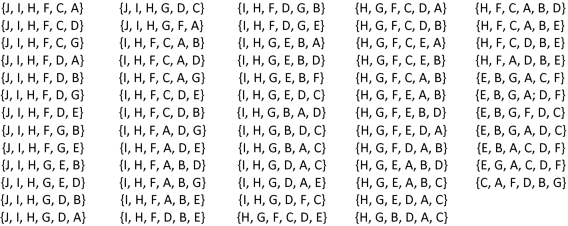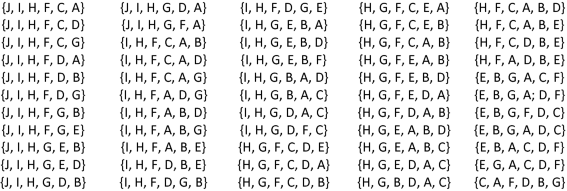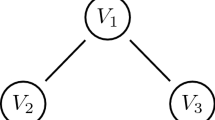Abstract
This paper applies power index analysis to the well-known Krackhardt’s kite social network by imposing a weighted voting game on the given network structure. It compares the results of this analysis, derived by applying the Public Good Index and the Public Value, with the outcome of employing the centrality concepts - degree centrality, closeness centrality, and betweenness centrality - that we find in Krackhardt (1990), and eigenvector centrality. The conclusion is that traditional centrality measures are rather a first approximation for evaluating the power in a network as they considerably abstract from decision making and thereby of possible coalitions and actions. Power index analysis takes care of decision making, however, in the rather abstract (a priori) form of the potential of forming coalitions.
Access this chapter
Tax calculation will be finalised at checkout
Purchases are for personal use only
Similar content being viewed by others
Notes
- 1.
Krackhardt refers to Freeman (1979) for definition and discussion of these concepts. E.g., degree centrality is defined as the number of links connected to the person. Closeness centrality is defined as the inverse of the average path distance between the actor and all others in the network. The definition of betweenness centrality needs a formal apparatus which will not be given here (see, e.g., Krackhardt 1990). See Sect. 4 of our paper.
- 2.
For a recent discussion of the PGI, see Holler (2019).
- 3.
Think about a committee that decides about hiring a professor to the department. Nodes A to G represent the tight sub-network of incumbent professors, H, I and J are the representatives of the President of the University – also representing the bureaucratic personnel -, the assistants, and the students, respectively.
- 4.
Fragnelli (2013) analyzes a weighted voting game with network structure applying the Banzhaf (power) index.
- 5.
In general, parliaments do not change their majority rules if links between parties have increased or decreased, and, in the extreme, a party became unconnected to any other like going from Γ and Γ1.
- 6.
- 7.
For his analysis of the kite network Krackhardt applied degree centrality, closeness centrality, betweenness centrality only. His argument not to consider measures based on eigenvector centrality is that they “aimed more at the concept of asymmetric status hierarchy, or “being at the top”, than they are at the idea of “being at the center”, which is the idea behind the graph-theoretic measures used here” Krackhardt (1990: 351).
- 8.
Krackhardt (1990) did not consider decision making. He focused on the cognitive problem of what network members know about the network and about other members of a network. Degree centrality, closeness centrality, and betweenness centrality might be reasonable instrument to evaluate one’s network position and the positions of the others – in fact, to recognize a network. “The central point” in his paper, however, is: “Cognitive accuracy of the informal network is, in and of itself, a base of power” (Krackhardt 1990: 343). The power index analysis dealt primarily with the formal structure, however, the links between the various nodes could be highly informal.
References
Algaba, E., López, S., Owen, G., Saboyá, M.: A game-theoretic approach to networks (2018). manuscript
Aumann, R., Myerson, R.B.: Endogenous formation of links between players and coalitions: an application of the shapley value. In: Roth, A. (ed.) the shapley value, pp. 175–191. Cambridge University Press, Cambridge (1988)
Barabasi, A.-L.: Network Science. Cambridge University Press, Cambridge (2016)
Bonacich, P.: Power and centrality: a family of measures. Am. J. Sociol. 92, 1170–1182 (1987)
Bozzo, E., Franceschet, M.: A theory on power in networks. Commun. ACM 59, 75–83 (2016)
Brandes, U.: A faster algorithm for betweenness centrality. J. Math. Sociol. 25, 163–177 (2001)
Brandes, U., Hildenbrand, J.: Smallest graphs with distinct singleton centers. Netw. Sci. 2, 416–418 (2014)
Fragnelli, V.: A note on communication structures. In: Holler, M.J., Nurmi, H. (eds.) Power, Voting, and Voting Power: 30 Years After, pp. 467–473. Springer, Heidelberg (2013). https://doi.org/10.1007/978-3-642-35929-3_24
Freeman, L.C.: Centrality in social networks: conceptual clarification. Soc. Netw. 1, 215–239 (1979)
Holler, M.J.: Forming coalitions and measuring voting power. Polit. Stud. 30, 262–271 (1982)
Holler, M.J.: The story of the poor public good index. Transaction on Computational Collective Intelligence (forthcoming) (2019)
Holler, M.J., Packel, E.W.: Power, luck, and the right index. J. Econ. (Zeitschrift für Nationalökonomie) 43, 21–29 (1983)
Holler, M.J., Li, X.: From public good index to public value: an axiomatic approach and generalization. Control Cybern. 24, 257–270 (1995)
Hubbell, C.H.: An input-output approach to clique identification. Sociometry 28, 377–399 (1965)
Krackhardt, D.: Assessing the political landscape: structure, cognition, and power in organizations. Adm. Sci. Q. 35, 342–369 (1990)
Myerson, R.B.: Graphs and cooperation in games. Math. Oper. Res. 2, 225–229 (1977)
Newmann, M.E.J.: Networks: An Introduction. Oxford University Press, Oxford (2010)
Salancik, G.R., Pfeffer, J.: Who gets power and how they hold onto it: a strategic-contingency model of power. Organ. Dyn. 5, 3–21 (1986)
Todeschini, R., Consonni, V.: Molecular Descriptors for Chemoinformatics, Volumes I & II. Wiley-VCH, Weinheim (2009)
Author information
Authors and Affiliations
Corresponding author
Editor information
Editors and Affiliations
Appendix
Appendix
-
1.
Set of minimal winning coalitions of the voting game v = (6; 1, 1, 1, 1, 1, 1, 1, 1, 1, 1) given Krackhardt’s kite network:

-
2.
Set of minimal winning coalitions of the voting game v = (7; 1, 1, 1, 1, 1, 1, 1, 1, 1, 1), representing a 2/3 quorum, given Krackhardt’s kite network:

-
3.
Set of minimal winning coalitions of the voting game v = (6; 1, 1, 1, 1, 1, 1, 1, 1, 1, 1), given the D-modified Krackhardt’s kite network:

-
4.
Set of minimal winning coalitions of the voting game v = (7; 1, 1, 1, 1, 1, 1, 1, 1, 1, 1), representing a 2/3 quorum, given the D-modifiedKrackhardt’s kite network:

Rights and permissions
Copyright information
© 2019 Springer-Verlag GmbH Germany, part of Springer Nature
About this chapter
Cite this chapter
Holler, M.J., Rupp, F. (2019). Power in Networks: A PGI Analysis of Krackhardt’s Kite Network. In: Nguyen, N., Kowalczyk, R., Mercik, J., Motylska-Kuźma, A. (eds) Transactions on Computational Collective Intelligence XXXIV. Lecture Notes in Computer Science(), vol 11890. Springer, Berlin, Heidelberg. https://doi.org/10.1007/978-3-662-60555-4_2
Download citation
DOI: https://doi.org/10.1007/978-3-662-60555-4_2
Published:
Publisher Name: Springer, Berlin, Heidelberg
Print ISBN: 978-3-662-60554-7
Online ISBN: 978-3-662-60555-4
eBook Packages: Computer ScienceComputer Science (R0)







